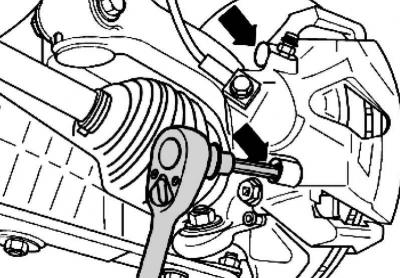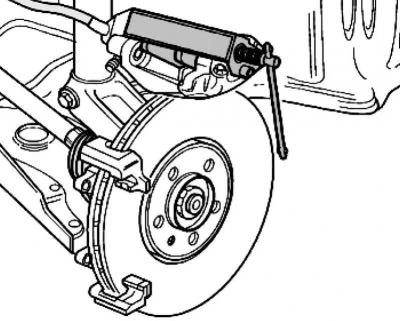Removing
Mark the brake pads if they are to be reused. They must be installed back in their places, otherwise there will be an uneven distribution of braking forces between the wheels.
Remove wheels.

Pic. 6.13. Removing the retaining spring
Pry and remove the brake pad retaining springs with a screwdriver from the brake caliper (pic. 6.13).

Pic. 6.14. plug connection
Disconnect the plug connection 1 of the brake pad wear indicator (pic. 6.14).

Pic. 6.15. caps
Remove caps (pic. 6.15).

Pic. 6.16. Removing guide bolts
Unscrew both guide bolts and remove from the brake caliper (pic. 6.16).
Remove the brake caliper and secure it with wire so that its weight does not press on the brake hose and damage it.
Remove the brake pad from the brake caliper or remove from the holder.
Attention: Do not blow out the brake system with compressed air. This creates harmful dust.
Clean the bearing surface of the brake pads on the bracket-holder, remove corrosion.
Clean the brake calipers.
Use only alcohol to clean the brake caliper.
Installation
Before pressing the piston into the cylinder using a special device, it is necessary to pump out the brake fluid from the reservoir. Otherwise, if liquid is topped up, it may leak out and cause damage.

Pic. 6.17. Piston removal
Press the piston (pic. 6.17).
Install the outer brake shoe into the retaining bracket.
Insert the inner brake shoe with retaining spring into the brake caliper (piston).
Attach the brake caliper with two guide bolts to the bracket (pic. 6.16).
Install both caps.
Install the retaining spring into the brake caliper.
Connect the plug connection of the brake pad wear indicator.
Install wheels.
Note: After each replacement of the brake pads, depress the brake pedal firmly several times. This is necessary in order for the brake pads to take their working position.
Note: After replacing the pads, check the brake fluid level.
Torque
Guide bolt to holder bracket: 30 Nm.

Visitor comments